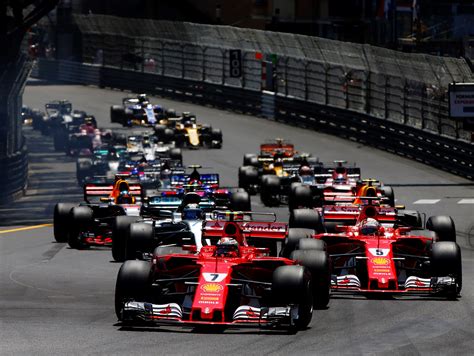Formula 1 Grand Prix: High-Speed Races Across the Globe

Explore the history, technology, famous circuits, aerodynamics, and legendary drivers of Formula 1 in this informative blog post. Uncover the evolution of racing.Welcome to our blog, where we will be taking a deep dive into the exhilarating world of Formula 1 Grand Prix racing. This high-speed sport has captured the hearts of millions of fans around the world, and we are here to explore the history, technology, and impact of this adrenaline-fueled sport.
In this blog post, we will be delving into the rich history of Formula 1, tracing its roots back to the early days of motor racing and exploring how it has evolved into the pinnacle of motorsport today. We will also be taking a look at the cutting-edge technology that drives these high-speed machines, as well as the most iconic Grand Prix circuits that have become the battlegrounds for some of the most epic races in history. Additionally, we will examine the crucial role of aerodynamics in pushing the limits of speed in Formula 1, and we will highlight some of the most famous and influential drivers who have left an indelible mark on the sport. So buckle up and get ready for a thrilling ride through the world of Formula 1.
History of Formula 1
Formula 1, also known as F1, is the highest class of international auto racing for single-seater formula racing cars. The history of Formula 1 can be traced back to the first Grand Prix races that were held in the early 1900s. However, the official Formula 1 World Championship began in 1950, with the inaugural race taking place at Silverstone, United Kingdom. Since then, Formula 1 has evolved into a global phenomenon, attracting millions of fans and becoming one of the most popular and prestigious racing events in the world.
Throughout its history, Formula 1 has seen many iconic drivers, teams, and technological advancements that have shaped the sport into what it is today. From the dominance of legendary drivers like Juan Manuel Fangio and Ayrton Senna to the groundbreaking engineering innovations that have pushed the limits of speed and performance, Formula 1 has a rich and storied history that continues to captivate audiences around the world.
Over the years, Formula 1 has expanded its reach to countries across the globe, holding races in diverse and exotic locations such as Monaco, Singapore, and Abu Dhabi. The sport has also undergone significant changes in regulations, safety standards, and broadcasting technologies, making it a constantly evolving and exciting spectacle for racing enthusiasts and casual fans alike. The history of Formula 1 is a testament to the passion, dedication, and innovation that have made it a cornerstone of the motorsport world.
Evolution of Racing Technology
Racing technology has come a long way since the early days of Formula 1. In the early years of the sport, cars were built with simple tubular frames and relied on mechanical components for power. As technology advanced, so did the design of racing cars. Engineers began to experiment with aerodynamics and materials to improve the speed and performance of the cars.
One of the most significant advancements in racing technology was the introduction of computer-aided design and engineering. This allowed teams to create more efficient and aerodynamic cars, giving them a competitive edge on the track. Additionally, the development of advanced tire compounds and suspension systems further enhanced the handling and agility of the cars, resulting in faster lap times and more thrilling races.
Today, racing technology continues to evolve with the integration of hybrid powertrains and advanced telemetry systems. These advancements not only improve the speed and efficiency of the cars but also contribute to the overall safety of drivers and spectators. With ongoing research and development, the future of racing technology holds even greater potential for pushing the limits of speed and performance in Formula 1.
Most Iconic Grand Prix Circuits
Formula 1 is known for holding its races at some of the most iconic circuits around the world. These circuits have gained legendary status due to their challenging layouts, historical significance, and thrilling races that have taken place on their tarmac. One such circuit is the Monaco Grand Prix circuit, which winds through the narrow streets of Monte Carlo and is known for its glamour and prestige. Another iconic circuit is the Silverstone Circuit in England, which hosted the first ever Formula 1 race in 1950 and is loved by drivers for its high-speed corners and undulating terrain.
Another iconic circuit on the Formula 1 calendar is the Spa-Francorchamps Circuit in Belgium, which is known for its challenging corners and unpredictable weather. The Monza Circuit in Italy is also a legendary track, with its long straights and high-speed chicanes making it a favorite among fans and drivers alike. The Suzuka Circuit in Japan is another iconic circuit, known for its demanding layout and challenging corners that test the skills of even the most seasoned drivers.
These are just a few examples of the most iconic Grand Prix circuits in Formula 1, each with its own unique characteristics and history that make them stand out in the world of motorsport.
Impact of Aerodynamics on Speed
Impact of Aerodynamics on Speed
Aerodynamics plays a crucial role in determining the speed and performance of Formula 1 cars. The intricate design of the car’s body and wings is aimed at reducing drag and increasing downforce to maximize speed and cornering ability. With advancements in aerodynamic technology, Formula 1 teams are constantly striving to gain a competitive edge through innovative designs and testing.
Aerodynamic principles are applied to enhance the car’s speed by manipulating airflow around the vehicle. This is achieved through the use of front and rear wings, diffusers, and other aerodynamic components that are carefully engineered to optimize performance. The shape and angle of these components are meticulously designed to minimize air resistance and create the necessary downforce to keep the car grounded at high speeds.
Furthermore, the impact of aerodynamics on speed extends beyond straight-line performance. By effectively managing airflow, Formula 1 cars are able to maintain higher speeds through corners, resulting in faster lap times. The evolution of aerodynamic designs has led to dramatic improvements in overall speed and agility, making it a crucial aspect of Formula 1 racing.
Famous Formula 1 Drivers
Formula 1 has seen some of the most legendary drivers in the history of motorsports. These drivers have not only showcased their exceptional driving skills, but have also left an indelible mark on the sport with their remarkable achievements and contributions.
One of the most iconic names in Formula 1 history is Ayrton Senna. The Brazilian driver is widely regarded as one of the greatest drivers of all time, with his aggressive driving style and exceptional talent behind the wheel. Senna’s rivalry with Alain Prost and his tragic death at the San Marino Grand Prix in 1994 have only added to his legendary status.
Another legendary figure in the world of Formula 1 is Michael Schumacher. The German driver holds the record for the most World Championship titles, with seven to his name. Schumacher’s dominance on the track and his strategic driving tactics have solidified his place as one of the greatest drivers in the history of the sport.





